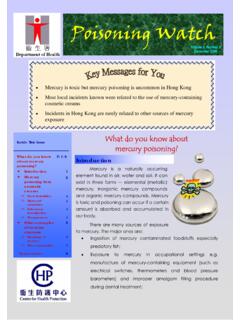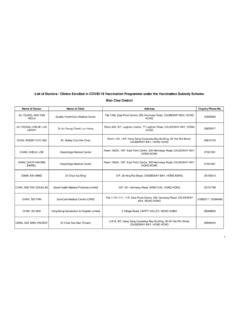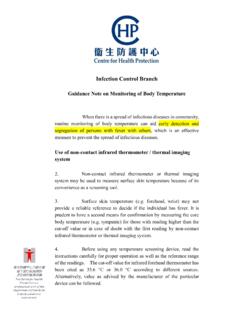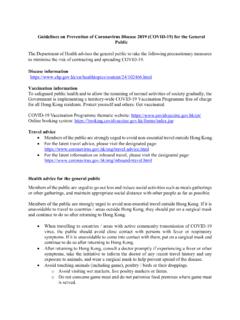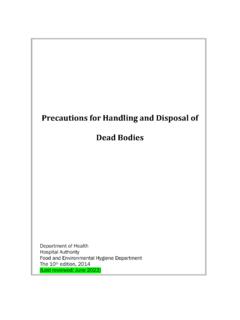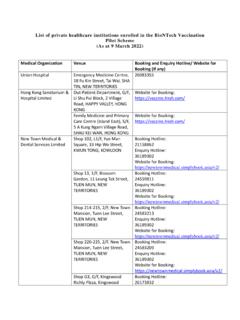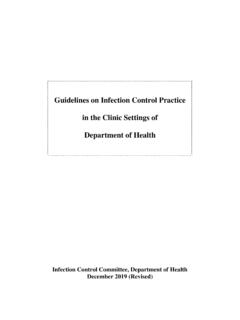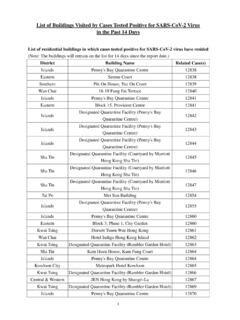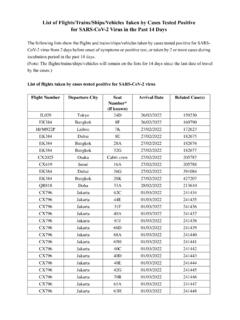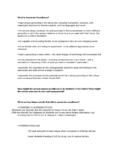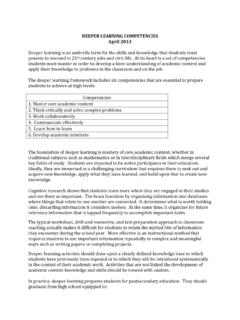Transcription of 10 Recommendations for Prescribing Exercise to Overweight ...
1 1010 Recommendations forPrescribing Exercise toOverweight andObese PatientsRecommendations for Prescribing Exercise to Overweight and Obese Patients10 Effects of ExerciseThe increasing prevalence of obesity reflects a lack of energy balance in a large number of people who are consistently expending fewer calories than they consume. It is reasonable to assume that persons with relatively high daily energy expenditures would be less likely to gain weight over time, compared with those who have low energy expenditures. Research has shown that adults are more likely to maintain a healthy weight if they have an active lifestyle and reduce their physical inactivity (1-3). A systematic review of randomised control trials (RCTs) in early postmenopausal women suggested that walking at least 30 mins per day plus twice weekly resistance Exercise sessions was likely to be effective in preserving normal body weight (4). International consensus guidelines, based largely around data from epidemiological prospective studies also recommended that adults should engage in 45 to 60 mins of moderate-intensity physical activity per day to prevent transition to Overweight or obesity (5).
2 Currently, the specific types and amounts of activity required to prevent weight gain have not been well established using prospective study designs, and it is best to assume that the specific amount of physical activity that will help prevent unhealthy weight gain is a function that differs between individuals, but that in general more activity increases the probability of success (6).Despite the intuitive appeal of the idea that physical activity helps in losing weight, physical activity appears to produce only modest increments of weight loss beyond those achieved by dietary measures and its effects no doubt vary among people (7). A meta-analysis of RCTs on the effectiveness of physical activity for weight loss in obese individuals revealed physical activity (minimum of 45 mins 3 times a week) combined with diet (600 kcal/deficit or low fat) results in an approximate weight change of kg (95% CI to ) (range kg to kg) compared to diet alone at 12 months (1). Whilst the addition of physical activity on top of a dietary intervention enhanced weight loss, physical activity appeared to be less effective than diet as a sole weight loss intervention (8).
3 9191 Several observational studies have been conducted on the role of physical activity in preventing weight regain after an initial sizable weight loss (9-13). Although these studies had different study design and methodology, all of them focused on people who had lost 30 50 lb ( kg) and had not regained after several years. Studies using self-reported physical activity and energy expenditure generally support the notion that 60 90 mins of moderate-intensity physical activity per day might be necessary for weight maintenance after such large weight losses (11-12). Recommendations for Exercise PrescriptionAdults who are Overweight or obese should be encouraged to increase their physical activity levels even if they do not lose weight as a result, because physical activity can bring other health benefits such as reduced risk of type 2 diabetes and cardiovascular disease. Overweight or obese adults should be encouraged to perform at least 30 mins of at least moderate-intensity physical activity on 5 or more days a week.
4 The activity can be undertaken in one session or several lasting 10 mins or more. For those who have already achieved this level of activity, an increase in the amount of their physical activity is a reasonable component of any strategy to lose weight. It is generally estimated that 1 pound ( ) of body fat loss requires about 3,500 kcal of energy consumption. As studies on the effect of prescription of muscle strengthening Exercise on weight loss are limited, it seems reasonable to recommend Overweight /obese people to follow the same muscle strengthening Exercise Recommendations for the general population for having a balanced Exercise following is the recommended FITT framework for Prescribing aerobic exercises to people who are Overweight and obese: Recommendations *Frequency 5 days per week of aerobic exercises to maximise caloric expenditure(14).Intensity Moderate- to vigorous-intensity aerobic exercises should beencouraged. Some individuals may prefer doing vigorous Exercise as it is less timeconsuming, but vigorous Exercise is probably not appropriate for thevery obese (BMI > approximately 35 kg/m2) (8).
5 Individuals choosing to incorporate vigorous intensity activity into theirprogramme should do this gradually and after an initial 4 12 weekperiod of moderate-intensity activity (8).9292 TimeTo prevent obesity, people may need 45 to 60 mins of moderate-intensity aerobic activity each day unless they also reduce their energy intake (1).Patients who are Overweight or obese should be prescribed a volume of 45 to 60 mins of moderate-intensity activity a day (corresponding to approximately 225 to 300 mins/week of moderate-intensity physical activity or lesser amounts of vigorous physical activity) (5,8).People who have been obese and have lost weight should be advised they may need to do 60 to 90 mins of activity a day to avoid regaining of weight (1,5,8).Sedentary individuals should build up to their physical activity targets over several weeks, starting with 10 to 20 mins of physical activity every other day during the first week or two, to minimise potential muscle soreness and fatigue (8).
6 9393 TypeWalking is an excellent form of physical activity for Overweight and obese people (for obese, sedentary individuals, brisk walking often constitutes moderate-intensity physical activity.) (8).Weight-bearing physical activity may be difficult for some individuals with BMI over approximately 35 kg/m2, particularly for those with joint problems. For these individuals, gradually increasing non-weight-bearing moderate-intensity physical activities ( cycling, swimming, water aerobics, etc.) should be encouraged (8).* As many patients may present with comorbidities, it may be necessary to tailor the Exercise of Overweight or Obese Patients Before Recommending an Exercise ProgrammeIt is important to ensure that individuals have no contraindications to Exercise before commencing a physical activity programme. The presence of other comorbidities ( dyslipidaemia, hypertension, hyperinsulinaemia, hyperglycaemia, etc.) may increase the risk stratification for Overweight and obese individuals, resulting in the need for additional medical screening before Exercise testing.
7 The presence of musculoskeletal and/or orthopaedic conditions and limitations of Exercise capacity may require modifications to the Exercise testing procedure. Special ConsiderationsPrescription of higher physical activity targets ( >300 mins per week of moderate-intensity physical activity) only resulted in significantly greater weight loss when participants received additional support, such as inclusion of family members in programme, small group meetings with Exercise coaches or small monetary incentives, to help them to achieve their activity goals (15). When additional support is not provided, prescription of higher physical activity targets may not result in significantly greater weight loss than prescription of standard physical activity (8).References1. National Institute for Health and Clinical excellence (NICE). Obesity: the prevention, identification, assessmentand management of Overweight and obesity in adults and children. London: NICE; Kay SJ, Fiatarone Singh MA.
8 The influence of physical activity on abdominal fat: a systematic review of theliterature. Obes Rev 2006;7(2) Fogelholm M, Lahti-Koski M. Community health-promotion interventions with physical activity: does thisapproach prevent obesity? Scand J Nutr 2002;46(4) Asikainen TM, Kukkonen-Harjula K, Miilunpalo S. Exercise for health for early postmenopausal women: Asystematic review of randomised controlled trials. Sports Med 2004;34(11) Saris WH, Blair SN, van Baak MA, Eaton SB, Davies PS, Di Pietro L, et al. How much physical activity is enoughto prevent unhealthy weight gain? Outcome of the IASO 1st Stock Conference and consensus Rev 2003;4(2) Slentz, C. V., B. D. Duscha, J. L. Johnson, et al. Effects of the amount of Exercise on body weight, bodycomposition, and measures of central obesity: STRRIDE-A randomized controlled study. Arch. Intern. Med2004;164:31 Stephanick, M. L. Exercise and weight control. Exerc. Sport Sci. Rev 1993; 21:363 of obesity. A national clinical guideline.
9 Edinburgh (Scotland): Scottish Intercollegiate GuidelinesNetwork (SIGN); 2010 Klem, M. L., R. R. Wing, W. Lang, M. T. Mcguire, and J. O. Hill. Does weight loss maintenance become easierover time? Obes. Res 2000; 8:438 Mcguire, M. T., R. R. Wing, M. L. Klem, H. M. Seagle, and J. O. Hill. Long-term maintenance of weight loss:do people who lose weight through various weight loss methods use different behaviors to maintain theirweight? Int J Obes Relat Metab Disord 1998; 22:572 Schoeller, D. A., K. Shay, and R. F. Kusher. How much physical activity is needed to minimize weight gain inpreviously obese women? Am J Clin Nutr 1997; 66:551 Weinsier, R. L., G. R. Hunter, R. A. Desmond, N. M. Byrne, P. A. Zuckerman, and B. E. Darnell. Free-livingactivity energy expenditure in women successful and unsuccessful at maintaining a normal body weight. AmJ Clin Nutr 2002; 75:499 Wing, R. R., and J. O. Hill. Successful weight loss maintenance. Annu Rev Nutr 2001; 21:323 Exercise Prescription for Other Clinical Populations.
10 In Walter R Thompson; Neil F Gordon; Linda S Pescatello;ACSM s guidelines for Exercise testing and prescription. 8th ed. American College of Sports Medicine, 2010, Jeffery RW, Wing RR, Sherwood NE, Tate DF. Physical activity and weight loss: does Prescribing higher physicalactivity goals improve outcome? Am J Clin Nutr 2003;78(4)
